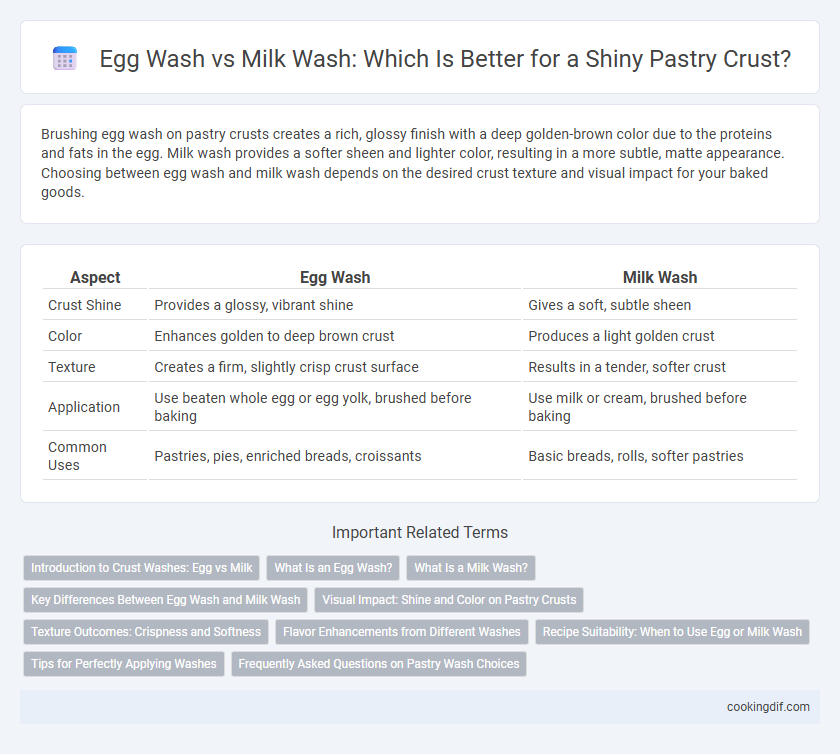Brushing egg wash on pastry crusts creates a rich, glossy finish with a deep golden-brown color due to the proteins and fats in the egg. Milk wash provides a softer sheen and lighter color, resulting in a more subtle, matte appearance. Choosing between egg wash and milk wash depends on the desired crust texture and visual impact for your baked goods.
Table of Comparison
| Aspect | Egg Wash | Milk Wash |
|---|---|---|
| Crust Shine | Provides a glossy, vibrant shine | Gives a soft, subtle sheen |
| Color | Enhances golden to deep brown crust | Produces a light golden crust |
| Texture | Creates a firm, slightly crisp crust surface | Results in a tender, softer crust |
| Application | Use beaten whole egg or egg yolk, brushed before baking | Use milk or cream, brushed before baking |
| Common Uses | Pastries, pies, enriched breads, croissants | Basic breads, rolls, softer pastries |
Introduction to Crust Washes: Egg vs Milk
Egg wash, composed of beaten eggs sometimes mixed with water or milk, provides a rich, glossy, golden-brown finish that enhances the visual appeal and texture of pastry crusts. Milk wash creates a softer sheen with a subtle browning effect, contributing to a tender crust surface but less intense shine compared to egg wash. Choosing between egg and milk washes depends on the desired crust color, texture, and overall appearance of baked goods.
What Is an Egg Wash?
An egg wash, typically made by beating whole eggs or egg yolks with a small amount of water or milk, is applied to pastries for a glossy, golden crust. Unlike milk wash, which provides a soft sheen and slight browning, egg wash delivers a richer color and a more pronounced shine due to its protein and fat content. This technique is essential in baking to achieve visually appealing, crisp, and shiny pastry surfaces.
What Is a Milk Wash?
A milk wash is a simple mixture of milk applied to pastry crusts before baking to enhance color and shine. It creates a soft, golden-brown finish with a subtle sheen, often preferred for delicate pastries where a lighter gloss is desired. Compared to egg wash, milk wash produces a less intense shine but adds a tender texture to the crust.
Key Differences Between Egg Wash and Milk Wash
Egg wash, composed of beaten eggs or egg yolk diluted with water or milk, provides a rich golden-brown color and a glossy, firm crust shine, ideal for enhancing the visual appeal of pastries and breads. Milk wash, typically whole or skim milk, offers a subtler, softer sheen with a slightly browner tone and tender crust texture, contributing to a delicate finish without the intense glossiness of egg wash. The key differences lie in egg wash's protein and fat content that promotes Maillard browning for vivid color and crispiness, whereas milk wash creates a mild shine and softer crust due to lactose and milk fat effects.
Visual Impact: Shine and Color on Pastry Crusts
Egg wash creates a deep golden-brown shine on pastry crusts, enhancing color intensity and producing a glossy, visually appealing finish. Milk wash offers a subtler sheen with a softer, matte finish and a light golden hue, ideal for a more delicate appearance. The choice between egg and milk wash directly influences the crust's visual impact, with egg wash delivering a high-gloss, vibrant color and milk wash providing a gentle, natural shine.
Texture Outcomes: Crispness and Softness
Brushing egg wash on pastry crusts creates a glossy, golden finish with a crisp texture due to the proteins and sugars that caramelize during baking. Milk wash imparts a softer, more subtle sheen while contributing to a tender crust because the lactose and proteins gently brown without forming a hard exterior. Choosing between egg and milk wash directly influences the pastry's final texture, balancing crispness versus softness depending on desired mouthfeel.
Flavor Enhancements from Different Washes
Egg wash imparts a rich, golden sheen with a slightly savory flavor that enhances the pastry's overall taste, making it ideal for savory pies and enriched breads. Milk wash produces a softer, matte finish with a subtle sweetness, subtly enhancing the crust flavor while maintaining a delicate texture. Choosing between egg and milk wash depends on the desired balance between crust shine, texture, and flavor complexity in pastries.
Recipe Suitability: When to Use Egg or Milk Wash
Egg wash creates a glossy, deep golden crust ideal for savory pies, breads, and pastries requiring rich color and shine. Milk wash produces a softer, matte sheen suitable for sweet baked goods like scones and biscuits where a gentle crust finish is desired. Choosing between egg or milk wash depends on recipe requirements for crust texture, color intensity, and flavor enhancement.
Tips for Perfectly Applying Washes
For a glossy, golden crust, apply egg wash using a soft pastry brush in thin, even layers to avoid pooling and sogginess. Use milk wash for a subtler shine and softer color, brushing gently just before baking to prevent dough saturation. Ensure the wash is room temperature and avoid over-brushing to maintain the pastry's crisp texture and enhance browning.
Frequently Asked Questions on Pastry Wash Choices
Brushing egg wash on pastry creates a richer, golden-brown crust due to its protein content that enhances browning through the Maillard reaction, while milk wash imparts a softer, subtler shine with a tender texture. Egg wash is preferred for a glossy, firm finish on pies, tarts, and croissants, whereas milk wash suits softer pastries where a gentle sheen is desired. Common FAQs highlight egg wash as ideal for a pronounced color and crispness, but milk wash is often chosen for a lighter color and less intense shine, catering to different visual and textural preferences in pastry presentation.
Brushing Egg Wash vs Milk Wash for crust shine Infographic

 cookingdif.com
cookingdif.com